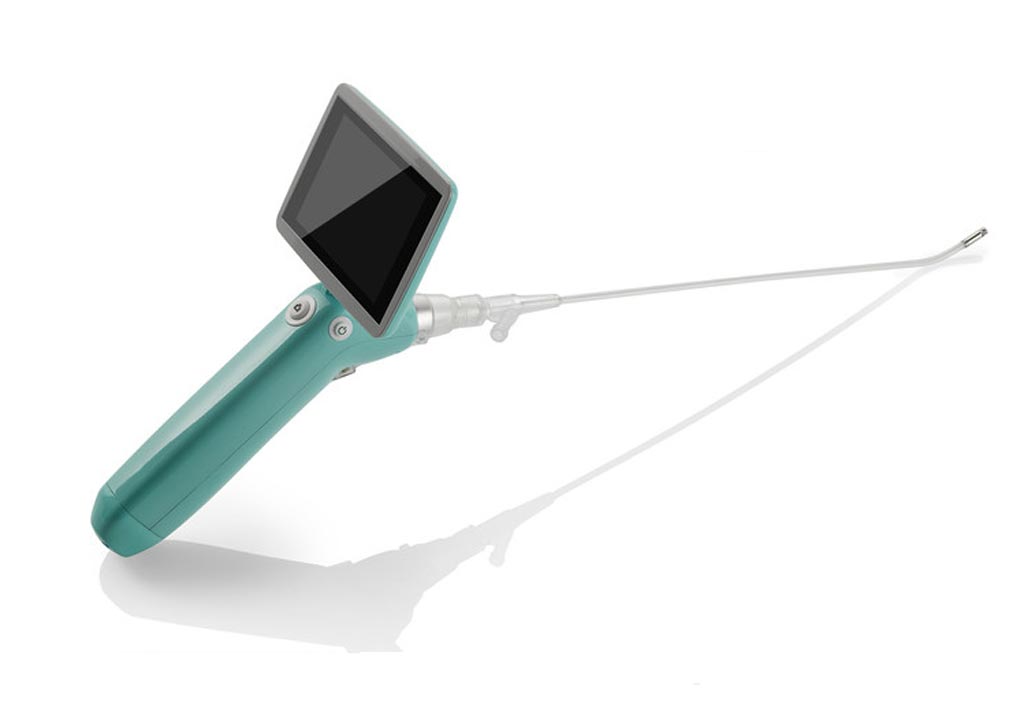Cystoscope Aids Assessment of Bladder and Urethra
|
By HospiMedica International staff writers Posted on 27 Mar 2018 |

Image: The portable diagnostic cystoscope is designed to eliminate cross-contamination (Photo courtesy of UroViu).
A single-use cystoscopic system aids endoscopic assessment of the lower urinary tract in instances of suspected pathology or dysfunction.
The UroViu (Bellevue, WA, USA) Uro-V cystoscope is a handheld, battery-operated, self-contained cystoscope that includes a sterile 12 French hydrophilic-coated disposable cannula and a reusable ergonomic handle. The disposable cannula contains an integrated miniature complementary metal-oxide semiconductor (CMOS) camera that provide a 140º field of view and a light-emitting diode (LED) illumination module, as well as an additional working channel for infusion of irrigating fluid.
The lightweight handle contains the remaining electronics, including a power (on/off) button, a button to adjust the brightness of the LED module, a button to allow capture of single images or to start/stop video recording of the procedure, a video processor, a touch screen liquid crystal diode (LCD) display, a rechargeable battery, management electronics, microcontrollers, and firmware. The handle includes a connector and locking mechanism for attaching and detaching the disposable cannula.
“The Uro-V Cystoscope has great potential to make the standard urological care more accessible and convenient for the patients while greatly reducing the burden of the urologists and staff,” said Professor Marshall Stoller, MD, of the department of urology at the University of California San Francisco (UCSF). “Uro-V substantially reduces the risk of cross-contamination while providing superior optics, unmatched portability, and tolerability, and allows for cystoscopy to be performed in any room and anytime.”
Standard flexible or rigid cystoscopes have been turned into the bottleneck of urology practices because they are bulky, require a dedicated procedure room and long setup time, and have a downtime as they need to be sterilized and reprocessed between patients; they are also expensive to own, maintain, and repair. Since high-level disinfection is not considered adequate for reprocessing, formal sterilization is expected to be required following each use in the very near future.
Related Links:
UroViu
The UroViu (Bellevue, WA, USA) Uro-V cystoscope is a handheld, battery-operated, self-contained cystoscope that includes a sterile 12 French hydrophilic-coated disposable cannula and a reusable ergonomic handle. The disposable cannula contains an integrated miniature complementary metal-oxide semiconductor (CMOS) camera that provide a 140º field of view and a light-emitting diode (LED) illumination module, as well as an additional working channel for infusion of irrigating fluid.
The lightweight handle contains the remaining electronics, including a power (on/off) button, a button to adjust the brightness of the LED module, a button to allow capture of single images or to start/stop video recording of the procedure, a video processor, a touch screen liquid crystal diode (LCD) display, a rechargeable battery, management electronics, microcontrollers, and firmware. The handle includes a connector and locking mechanism for attaching and detaching the disposable cannula.
“The Uro-V Cystoscope has great potential to make the standard urological care more accessible and convenient for the patients while greatly reducing the burden of the urologists and staff,” said Professor Marshall Stoller, MD, of the department of urology at the University of California San Francisco (UCSF). “Uro-V substantially reduces the risk of cross-contamination while providing superior optics, unmatched portability, and tolerability, and allows for cystoscopy to be performed in any room and anytime.”
Standard flexible or rigid cystoscopes have been turned into the bottleneck of urology practices because they are bulky, require a dedicated procedure room and long setup time, and have a downtime as they need to be sterilized and reprocessed between patients; they are also expensive to own, maintain, and repair. Since high-level disinfection is not considered adequate for reprocessing, formal sterilization is expected to be required following each use in the very near future.
Related Links:
UroViu
Latest Critical Care News
- 'Universal' Kidney to Match Any Blood Type
- Light-Based Technology to Measure Brain Blood Flow Could Diagnose Stroke and TBI
- AI Heart Attack Risk Assessment Tool Outperforms Existing Methods
- Smartphone Imaging System Enables Early Oral Cancer Detection
- Swallowable Pill-Sized Bioprinter Treats GI Tract Injuries

- Personalized Brain “Pacemakers” Could Help Patients with Hard-To-Treat Epilepsy
- Microscopic DNA Flower Robots to Enable Precision Medicine Delivery
- Origami Robots to Deliver Medicine Less Invasively and More Effectively
- Improved Cough-Detection Technology Aids Health Monitoring
- AI Identifies Children in ER Likely to Develop Sepsis Within 48 Hours
- New Radiofrequency Therapy Slows Glioblastoma Growth
- Battery-Free Wireless Multi-Sensing Platform Revolutionizes Pressure Injury Detection
- Multimodal AI to Revolutionize Cardiovascular Disease Diagnosis and Treatment
- AI System Reveals Hidden Diagnostic Patterns in Electronic Health Records
- Highly Sensitive On-Skin Sensing Monitor Detects Vitamin B6 and Glucose in Sweat
- Artificial Intelligence Revolutionizing Pediatric Anesthesia Management
Channels
Surgical Techniques
view channel
Minimally Invasive Endoscopic Surgery Improves Severe Stroke Outcomes
Intracerebral hemorrhage, a type of stroke caused by bleeding deep within the brain, remains one of the most challenging neurological emergencies to treat. Accounting for about 15% of all strokes, it carries... Read more
Novel Glue Prevents Complications After Breast Cancer Surgery
Seroma and prolonged lymphorrhea are among the most common complications following axillary lymphadenectomy in breast cancer patients. These postoperative issues can delay recovery and postpone the start... Read morePatient Care
view channel
Revolutionary Automatic IV-Line Flushing Device to Enhance Infusion Care
More than 80% of in-hospital patients receive intravenous (IV) therapy. Every dose of IV medicine delivered in a small volume (<250 mL) infusion bag should be followed by subsequent flushing to ensure... Read more
VR Training Tool Combats Contamination of Portable Medical Equipment
Healthcare-associated infections (HAIs) impact one in every 31 patients, cause nearly 100,000 deaths each year, and cost USD 28.4 billion in direct medical expenses. Notably, up to 75% of these infections... Read more
Portable Biosensor Platform to Reduce Hospital-Acquired Infections
Approximately 4 million patients in the European Union acquire healthcare-associated infections (HAIs) or nosocomial infections each year, with around 37,000 deaths directly resulting from these infections,... Read moreFirst-Of-Its-Kind Portable Germicidal Light Technology Disinfects High-Touch Clinical Surfaces in Seconds
Reducing healthcare-acquired infections (HAIs) remains a pressing issue within global healthcare systems. In the United States alone, 1.7 million patients contract HAIs annually, leading to approximately... Read moreHealth IT
view channel
Printable Molecule-Selective Nanoparticles Enable Mass Production of Wearable Biosensors
The future of medicine is likely to focus on the personalization of healthcare—understanding exactly what an individual requires and delivering the appropriate combination of nutrients, metabolites, and... Read moreBusiness
view channel
Philips and Masimo Partner to Advance Patient Monitoring Measurement Technologies
Royal Philips (Amsterdam, Netherlands) and Masimo (Irvine, California, USA) have renewed their multi-year strategic collaboration, combining Philips’ expertise in patient monitoring with Masimo’s noninvasive... Read more
B. Braun Acquires Digital Microsurgery Company True Digital Surgery
The high-end microsurgery market in neurosurgery, spine, and ENT is undergoing a significant transformation. Traditional analog microscopes are giving way to digital exoscopes, which provide improved visualization,... Read more
CMEF 2025 to Promote Holistic and High-Quality Development of Medical and Health Industry
The 92nd China International Medical Equipment Fair (CMEF 2025) Autumn Exhibition is scheduled to be held from September 26 to 29 at the China Import and Export Fair Complex (Canton Fair Complex) in Guangzhou.... Read more







.jpg)






